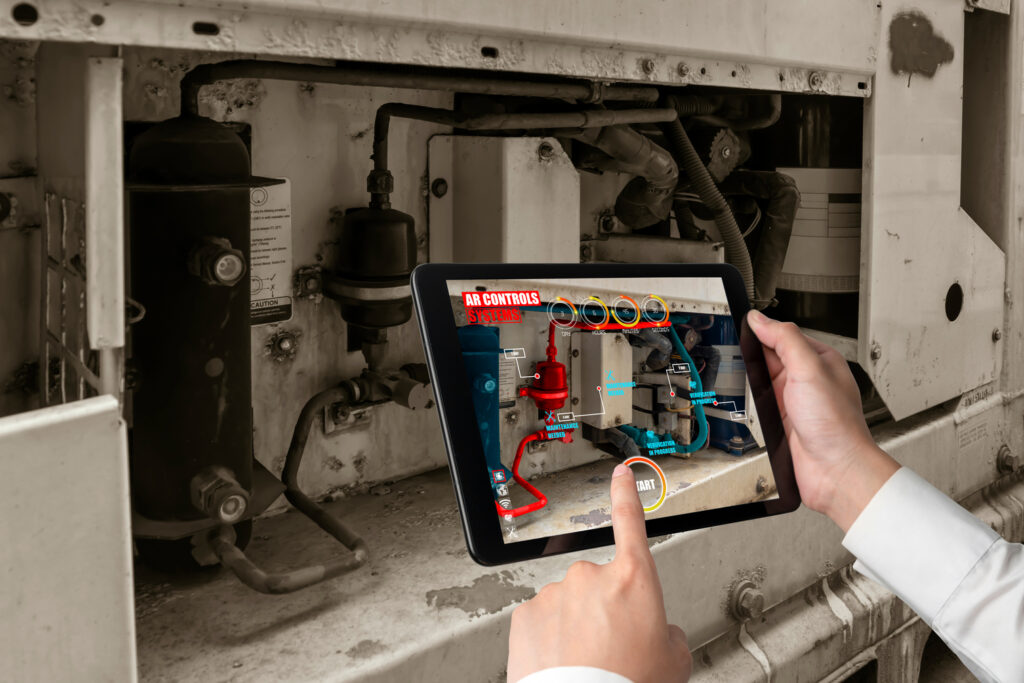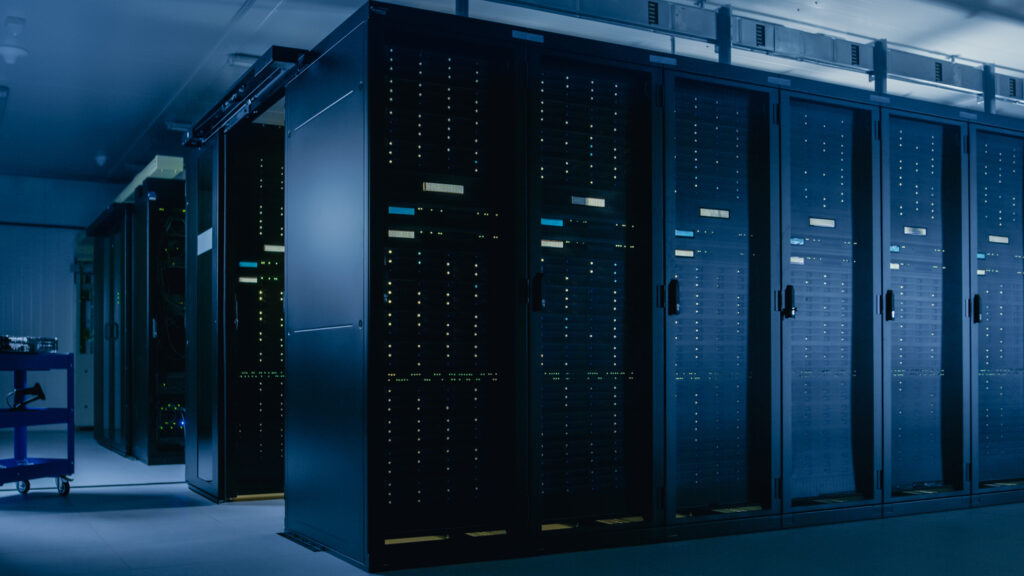Using HMI 101: meaning, trends and profits
As we enter the fourth wave of the industrial revolution and the technologies used in everyday life develop significantly, it is becoming increasingly important to interact with machines and electronic devices in the most effective way possible. Here, the Human-Machine Interface (HMI) comes in as a helpful solution that allows the user to easily communicate with a device.
In this publication, created in close collaboration with our expert Przemysław Nogaj, we focus on what HMI is and where it can be used. We also tackle the impact of new technologies on trends and the future of that area.
HMI meaning
HMI can be defined as a user interface or dashboard that allows interaction and communication between a human and a machine, device, program, or system. Many people use the term primarily to refer to screens, touchscreens, and keyboards in industrial settings, but in fact, it can be applied to all interfaces and interactions that allow communication with any type of device. Historically, the term was created with industrial machines in mind, but now with the growing use of wearable technologies and more digitally advanced home electronics, the HMI can be applied to all devices operated by the user in day-to-day life. Therefore, the modern understanding of the term HMI concerns all of us, whether we work in an industrial area or not.
The evolution of HMI comes from the historical use of solutions like Batch Processing and Command-Line Interfaces to the now commonly known Graphical User Interfaces and touchscreens. However, with more and more advanced technologies and commonly used everyday devices, it has to develop further. Therefore, the use of interfaces based not only on touch but also on gestures, voice interaction, and augmented reality is becoming more popular.
Regarding the HMI, I would call it more of a Human-Machine Interaction rather than just an Interface. I think that now, interaction should be the more dominant aspect of this technology. HMI is no longer just a simple interface between the operator and an industrial machine. In a world where electronic devices are everywhere, and we use them daily, it is crucial to understand the relevance of the HMI and its proper design. Devices nowadays must deal with many of the tasks of everyday life, so interacting with them should be quick and intuitive so that they can improve the user’s quality of life.
The use of HMI
HMI is used across several industries, in many devices and wearables, to ensure the most effective interaction with machines. This solution can help to optimise the gathering and processing of information, which results in making better and quicker decisions.
Industrial use of HMI occurs in sectors such as energy, wastewater, transportation, and healthcare, as well as in manufacturing various types of goods from cars and pharmaceuticals to food and beverages. The HMI can be particularly useful for controlling, monitoring and managing the manufacturing line, diagnosing problems and collecting and visualising data. In this case, it is utilised by professional operators and engineers.
Besides industrial usage, there are also HMI solutions incorporated in everyday devices. These days everyone has some sort of wearable, smart TVs, fridges and washing machines. All such devices require the presence of an HMI to meet the daily needs of users and should be designed to fit into their bodies, lives, and cognitive abilities.
Some illustrative examples of the use of HMI can be seen in sectors like automotive and healthcare. The first one can apply this solution to boost the functionality and comfort of the vehicle, or even to distinguish the car from other competitors in the market. It can help build brand loyalty and a bigger attachment to the car. Of course, the creation of a suitable HMI is left up to the carmakers. It is up to them to decide whether to use solutions similar to those of other companies, or to stand out and create their own system and a unique user experience.
As for the healthcare sector, HMI can be applied to both typical ambulatory machines and personal use devices. In this type of equipment, a properly created interface can improve the diagnostic process and the way of receiving information vital to our health, which can ultimately result in an elevated quality of life for the user or patient.
Trends and future of HMI
Constantly evolving technology and the new ways and habits in which we use it can encourage companies to develop more innovative solutions for Human-Machine Interaction. According to our expert Przemysław Nogaj, some of the biggest trends in this area are:
Voice interaction
Communication with the machine through voice and voice recognition is a trend that is already being implemented in many tools. Due to changing consumer habits, especially among young people, and the growing number of users who take voice interaction with the machine as a natural step, this trend will only grow in the future. This solution for many, especially young people, seems to be easier and less time-consuming since they don’t have to press any button or type any words, only say what they actually want.
Gestures interaction
Another trend that might seem slightly less natural and comfortable is operating the device with gestures. This solution may look effective but can be difficult and inconvenient to use in some cases. For example, in the automotive industry, where gesture interaction has been incorporated into cars, it has proven difficult to maintain the precision of movements, especially when driving. Overall, this technology still has some room for improvement, but with the right approach and modifications, it can be managed effectively.
At Spyrosoft we have our own concept about gestures in HMIs. Below you will find some thoughts from our expert – Przemysław Nogaj, about that idea:
We still think that touching, and feeling something under your hand, is rather a natural way of communicating between humans and machines. What is needed in this solution is more stability during the interaction. Therefore, our idea is based on gestures made on a touchscreen or touch-sensitive device. This would mean that the device doesn’t need to have a visual interface, but still allows a range of operations and commands to be performed using gestures that the user can quickly master. That solution could be applied, e.g., to cars where settings like air conditioning could be changed with a simple three-finger swipe to the left or right. This way, gestures are easier to perform, even without looking at the screen during the ride.
AR and XR tools
An important direction for HMI is the use of technologies like Extended and Augmented Reality. These solutions follow the growing interest of customers. Over the last few years, AR and XR tools have matured and devices such as Magic Leap have started to appear on the market. They are designed to eliminate the flaws and inconveniences of earlier versions of the technologies and to offer improved solutions. Augmented Reality tools also have great potential in the manufacturing area, where they can connect operators and enable them to interact with machines and data in real-time from different locations. Such a solution supports the mobility of employees and increases their efficiency and productivity.
To learn more about AR check our Augmented reality 101 article.
AI and Machine Learning
The primary goal of HMI is to make the interaction between user and device easier. Therefore, the use of AI-powered HMI, which makes devices and communication processes with them smarter, seems to be a natural step in the future. In time, this solution can help to gather big amounts of data that will lead to a better human-machine understanding. The system will be able to learn the user behaviour and its context, and then adapt that knowledge and make suggestions, which will improve the decision-making process and efficiency of the machine.
Gamification
An interesting trend in HMI is also the use of solutions that allow the gamification of interactions with devices. As humans, we like to be rewarded through prizes, new experiences, or new achievements, such as the acknowledgement of making our 100th coffee in the coffee machine. All this makes us want to interact further and see what happens next. Thanks to that, we are more involved and motivated, which can contribute to the further use of a device, or general way of work.
Robotics
Another trend comes from the ever-evolving field of robotics and the need to determine what the Human-Machine Interfaces should look like in that area. There is some fear that machines will become too human. Therefore, manufacturers must not overdo the humanoid appearance of their devices, as this may cause some resistance among consumers. However, people still like to see some small human elements in machines, like emotions. This could be easily solved with a display that shows emojis as a reaction to interaction with a person. This allows us to build a relationship with the machine and also to create some brand loyalty.
Neurological connection
To look even further into the future, there are already ideas like Neuralink, that want to create a neurological connection between people and machines. This technology aims to make it possible to control the device with your thoughts and to receive information through sensory feedback. This concept may, still, sound like an abstraction, but it is something that seems to be the next step in improving communication with machines. It would certainly help eliminate some time-consuming steps in the interaction and thus make the entire process faster and more productive.
Benefits of using HMI
These days, accurate HMI is especially important. In a world of another industrial revolution and societies more often described as augmented societies, most people can’t imagine living without machines and electronic devices. Therefore, the ability to properly connect with machines seems to be crucial for the quality of our everyday life.
The use of HMI in various machines, wearables, and devices has many benefits. In day-to-day life, it can help us to get any information we need much quicker, and to conduct daily tasks more conveniently and comfortably. These two are extremely important issues considering how fast we live today, and the information load we are facing. Additionally, HMI combined with the newest technologies can help expand our reality and explore the world in ways we have not known before. For example, interfaces with AR and XR can entirely change our way of travelling. We no longer need paper maps, travel guides or informational stands, all we need is adequate HMI that will give us information about any museum or gallery in real-time and directly to us.
Good HMI can also bring many advantages to industrial businesses. Some of these benefits are:
- Simplification of manufacturing processes and operations.
- Ability to get easy access to critical information and real-time data.
- Providing quick, real-time feedback and remote access to the machines.
- Possibility of customising and personalising the user interface for maximum ease of use and functionality.
- Reducing downtime and improving efficiency and productivity, thus decreasing costs and waste.
Over to you
The future of HMI is shaped by new and constantly innovating technologies. Things like cloud computing, voice recognition, AR, machine learning, IoT and cognitive computing are all likely to have a great impact on the development of future Human-Machine Interfaces.
If you would like to know how to apply the newest HMI solutions and what advantages they can bring to your organisation, get in touch with our team.
About the author
RECOMMENDED READING:
CONTACT US




